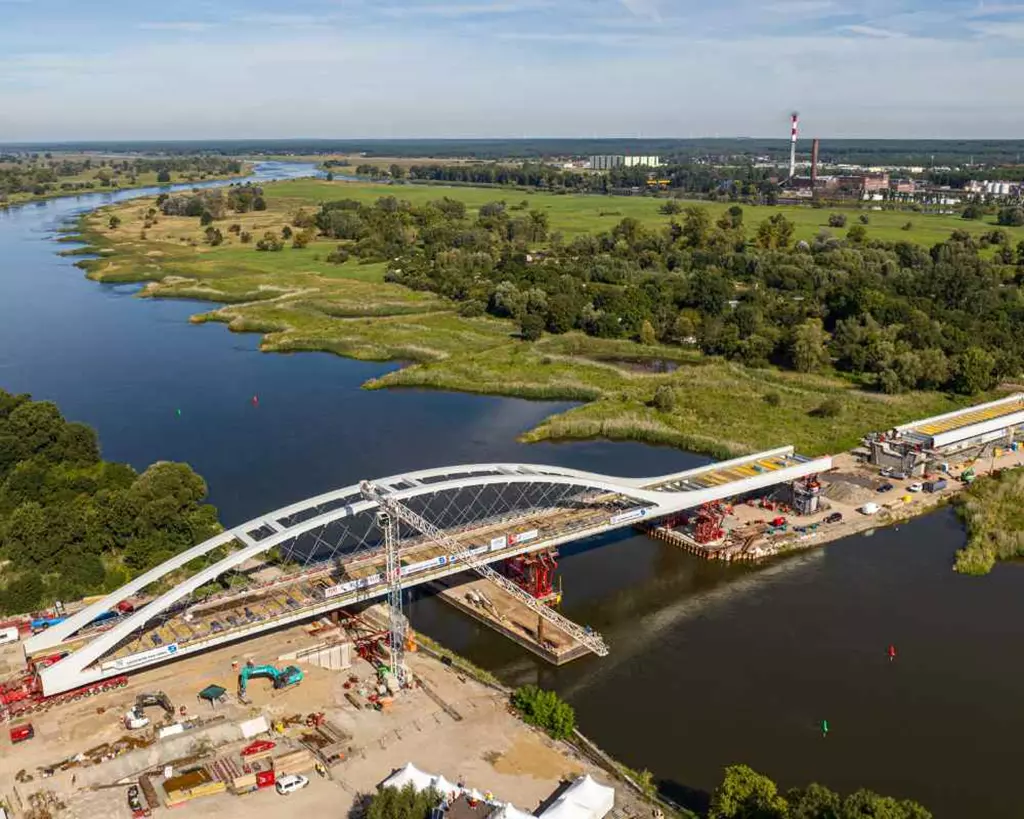
Küstrin, Germany – In a remarkable feat of engineering, Mammoet, a global leader in heavy lifting and transport solutions, has successfully installed the new Oder Bridge on the German-Polish border, marking a milestone in the region’s infrastructure development.
A Bridge Symbolizing Unity
Built over a century ago, the Oder Bridge has long been a symbol of Europe coming together, connecting Western and Eastern Europe. However, with the wear and tear from heavy transport, the need for replacement arose. The challenge was not just replacing a historic railway bridge but doing so with minimal disruption to the rail network.
Innovative Design for Efficiency
The new Oder Bridge is an innovation in itself—a network arch bridge with carbon hangers. Its sleek, light, and soft design embodies innovation, openness, and connection. With a weight of 2,100 tons and a length of 180 meters, the bridge aims to increase line capacity and reduce travel times by allowing a maximum permissible speed of 120 km/h.
Mammoet’s Expertise in Action
Mammoet, with its extensive experience in large-scale bridge launches, was the natural choice for this intricate project. The company specializes in moving bridges as complete structures, allowing parallel work in the preparation phase and ultimately saving time.
Koen Brouwers, Project Manager at Mammoet, highlighted the uniqueness of this project: “Most bridges are floated into place using a combination of Mammoet Self-Propelled Modular Transporters (SPMTs), launching plates, and a pontoon. However, a pontoon was not feasible here due to the shallow and changing water levels of the river.”
Depth-Defying Challenge

The bridge assembly took place on the German side of the Oder and then, as a whole structure, moved across the river to its final installation position. According to Brouwers, Mammoet’s engineers devised a solution that avoided the use of both a crane and a pontoon, making the operation more flexible, safer, and efficient, regardless of the water level.
Around 45 truckloads of specialized heavy equipment, including SPMTs, launching plates, climbing jacks, and strand jacks, were mobilized for the project.
Plate Spinning and Customization
To address the risk of deformation during the launch process, Mammoet’s engineering team utilized temporary supports with hydraulic cylinders and modified launching plates. Jack van der Vloet, Lead Engineer at Mammoet, emphasized the challenge of wind loads and the need for modifications to the launching plates to ensure full control of the operation.
The entire skidding equipment had to be customized for the operation, with Mammoet Europe utilizing all available launching plates from their stock due to the bridge’s size.

New Method for Success
Infrastructure projects are vital for supporting growing populations and economies, and Mammoet’s innovative approach showcases the importance of early involvement in the preparation phase. Uwe Richter, Senior Sales Manager at Mammoet, emphasized the significance of technical and feasibility studies to determine the best solution with the customer.
Compared to traditional methods involving cranes or pontoons, Mammoet’s use of modified launching plates presents a smart solution that can be adapted for other bridge projects where traditional methods prove inefficient or impractical.
Souece:Mammoet
